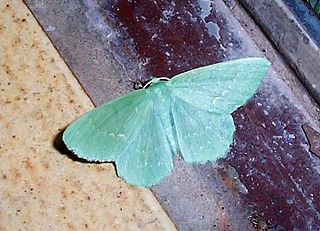
The Geometroidea are the superfamily of geometrid moths in the order Lepidoptera. It includes the families Geometridae, Uraniidae, Epicopeiidae, Sematuridae, and Pseudobistonidae. The Geomeatroidia superfamily has more than 24,000 described species, making them one of the largest superfamilies inside the order Lepidoptera. The monotypic genus Apoprogones was considered a separate geometroid family of the Apoprogonidae by a minority, but is now subsumed under the Sematuridae.

Emperor Xizong of Tang, né Li Yan, later name changed to Li Xuan, was an emperor of China's Tang dynasty. He reigned from 873 to 888. He was the fifth son of his predecessor Emperor Yizong and was the elder brother of his successor Emperor Zhaozong. His reign saw his realm overrun by the great agrarian rebellions led by Wang Xianzhi and Huang Chao, and while both were eventually defeated, by the end of Emperor Xizong's reign, the Tang state had virtually disintegrated into pieces ruled by individual warlords, rather than the imperial government, and would never recover, falling eventually in 907.

Epicopeiidae is a family of insects in the order Lepidoptera. They are known as oriental swallowtail moths as they closely resemble some oriental swallowtail butterflies. Epicopeiidae have highly varied structure in regards to body size and wing shape. Epicopeiidaen wing patterns are involved in complicated mimicry rings.
Ammatho is a genus of erebid moths, first described by Francis Walker in 1855.
Barsine is a genus of moths in the family Erebidae.
Camptoloma is a genus of moths in the family Nolidae. It was formerly incorrectly placed in Arctiidae.

Ussuriana is an east Palearctic genus of butterfly in the family Lycaenidae.
Psecadioides is a genus of moths belonging to the family Tineidae.

Pelodiscus is a genus of turtles in the family Trionychidae, the softshells. Based on genetic and morphological analysis there are seven valid species. They are native to Eastern Asia, ranging from the Amur region, south through China and Korea, as far south as Vietnam. Populations in Japan are thought to likely originate from historic human introductions.

Prismosticta is a genus of moths of the family Endromidae first described by Arthur Gardiner Butler in 1880. The genus was previously placed in the subfamily Prismostictinae of the family Bombycidae.

Dicallomera is a genus of tussock moths in the family Erebidae.

Prismosticta fenestrata is a moth in the family Endromidae first described by Arthur Gardiner Butler in 1880. It is found in China, Taiwan, India and Nepal.
The Guangzhou massacre was a massacre of the inhabitants of the prosperous port city of Guangzhou in 878–879 by the rebel army of Huang Chao. Arab sources indicate that foreign victims, including Muslims, Jews, Christians, and Zoroastrians, numbered in tens of thousands based on Chinese records of prior inhabitants. Two travellers from the Abbasid Caliphate, Abu Zaid al Hassan from Siraf writing decades afterwards, and al-Masudi writing in the 10th century, estimated that 120,000 or 200,000 foreigners were killed respectively, but according to Morris Rossabi, the numbers were inflated.

Psychostrophia is a genus of moths in the family Epicopeiidae. The genus was erected by Arthur Gardiner Butler in 1877.
Chatamla is a monotypic moth genus in the family Epicopeiidae described by Frederic Moore in 1881. Its only species, Chatamla flavescens, was described by Francis Walker in 1854. It is found in northern India.
Schistomitra funeralis is a moth species in the family Epicopeiidae described by Arthur Gardiner Butler in 1881. It is found in Japan, where it has been recorded from Honshu, Shikoku and kyushu.
Changzuiornis is an extinct genus of ornithuromorph bird from the Early Cretaceous of present-day China. It contains a single species, C. ahgmi.

Schistomitra joelmineti is a moth species in the family Epicopeiidae described by Si-Yao Huang and Yuan Zhang in 2019. The specific epithet is named in honor of Joël Minet

Mimaporia is a genus of moths in the Oriental swallowtail moth family Epicopeiidae consisting of two species, Mimaporia hmong and Mimaporia owadai. First described in 2017 by Shen-Horn Yen and Chia-Hsuan Wei, as the sole species Mimaporia hmong, from museum specimens held at the Natural History Museum, London. The second species, Mimaporia owadai was discovered two years after the initial description. Its members are found in Northern Vietnam, Northern India, and Sichuan Province in China.










